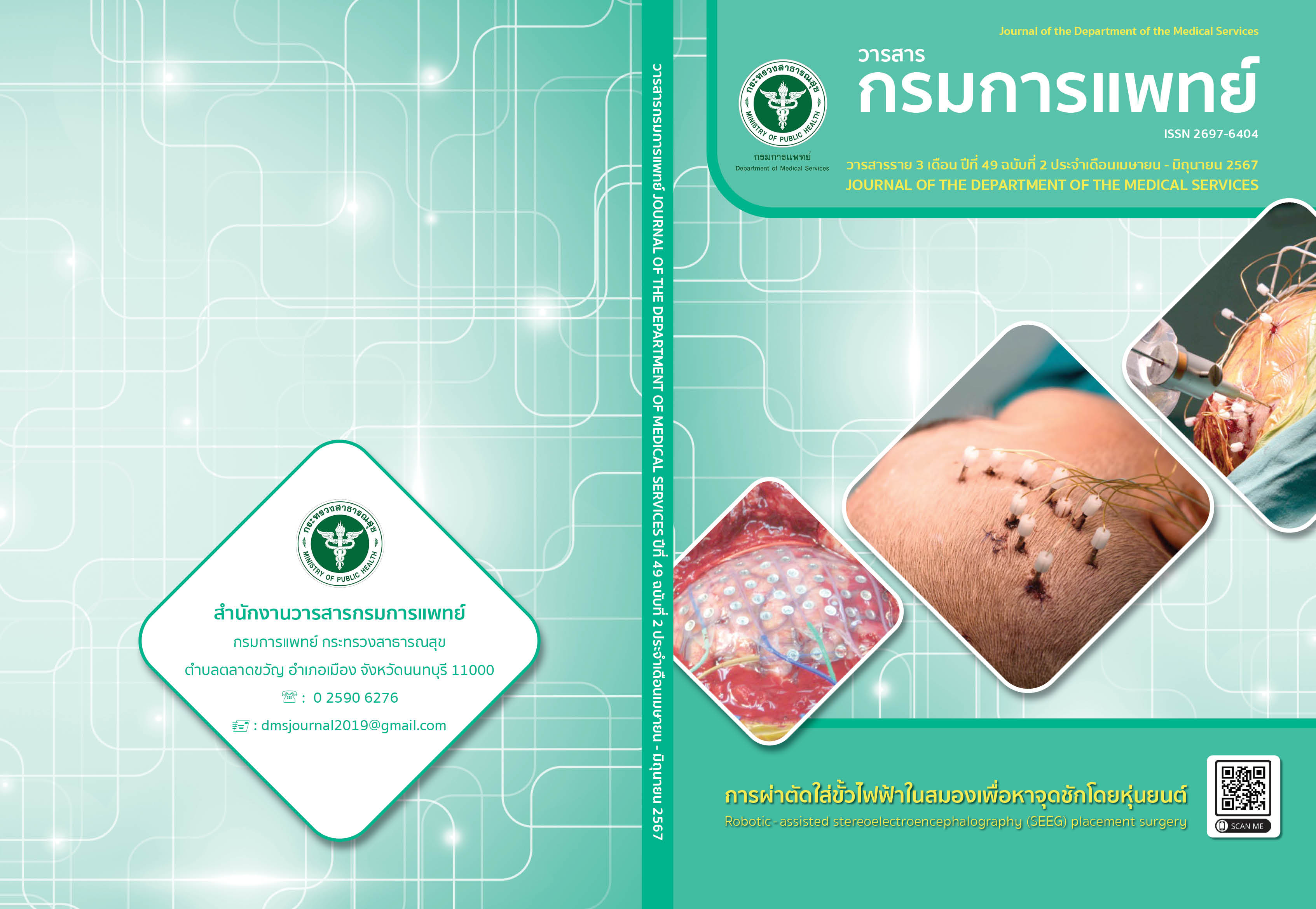ผลการตรวจ Next-generation Sequencing และความสัมพันธ์ทางคลินิกในเด็กที่ไม่ทราบสาเหตุของโรคลมชัก ณ โรงพยาบาลเด็กระดับตติยภูมิในประเทศไทย
คำสำคัญ:
โรคลมชักสาเหตุจากพันธุกรรม, เด็ก, เทคโนโลยีการถอดรหัสทางพันธุกรรมบทคัดย่อ
ภูมิหลัง: Next - generation sequencing (NGS) เป็นวิธีการตรวจที่มีบทบาทสำคัญมากขึ้นในการระบุสาเหตุที่ ไม่ทราบของโรคลมชักในเด็กช่วยเพิ่มผลการวินิจฉัยสาเหตุของโรคลมชักที่เกิดในเด็กได้อย่างน้อยร้อยละ 30 - 40 แต่ประเทศไทยยังมีข้อมูลเหล่านี้อย่างจำากัด วัตถุประสงค์: เพื่อหาผลการวินิจฉัยและปัจจัยที่เกี่ยวข้องกับการตรวจหายีนที่ก่อให้เกิดโรคด้วย NGS ในเด็กที่เป็นโรคลมชักที่ไม่ทราบสาเหตุในประเทศไทย วิธีการ: การศึกษาย้อนหลังแบบสถาบันเดียว ของเด็กที่เป็นโรคลมชักไม่ทราบสาเหตุจำนวน 42 ราย ซึ่งมีผลการตรวจ NGS สำหรับการวินิจฉัยโรคลมชักจากพันธุกรรม ตั้งแต่วันที่ 1 มกราคม พ.ศ. 2558 ถึง 30 มิถุนายน พ.ศ. 2564 ดำเนินการที่สถาบันสุขภาพเด็กแห่งชาติมหาราชินีประเทศไทย โดยไม่รวมผู้ป่วยที่ทราบสาเหตุของโรคลมชัก ความแตกต่างทางพันธุกรรมถูกจำแนกตามความสามารถในการก่อโรคและพิจารณาปัจจัยทางคลินิกที่เกี่ยวข้อง ผล: ผู้ป่วย 42 รายที่ไม่ทราบสาเหตุของโรคลมชัก ได้รับการตรวจทางพันธุกรรมและมีผลการตรวจ พบว่าร้อยละ 50 ตรวจพบยีนที่ก่อให้เกิดโรคและเป็นสาเหตุทางพันธุกรรมของโรคลมชัก ในผู้ป่วย 21 รายที่มีโรคลมชักทางพันธุกรรมที่ได้รับการวินิจฉัย โดย NGS พบว่าร้อยละ 57.1 เป็นเพศหญิง ร้อยละ 33.3 มีประวัติครอบครัวเป็นโรคลมชัก ร้อยละ 4.8 มีประวัติแต่งงานในเครือญาติ และทั้งหมดมีพัฒนาการล่าช้า พบว่ายีนที่ก่อให้เกิดโรคที่พบมากที่สุดคือ SCN1A (ร้อยละ 38.1) โดยปัจจัยที่เกี่ยวข้องอย่างมีนัยสำคัญกับการตรวจพบยีนที่ก่อให้เกิดโรค คือ Dravet phenotype (p - value = .004) และพารามิเตอร์ทางคลินิกอื่น ๆ ไม่ใช่ปัจจัยที่มีนัยสำคัญ นอกจากนี้ มีการเปลี่ยนแปลงการรักษาของผู้ป่วยที่ได้รับการวินิจฉัย หลังจากทราบผล NGS อย่างมีนัยสำคัญในผู้ป่วยโรคลมชัก ทางพันธุกรรมที่ได้รับการวินิจฉัยโดย NGS มากกว่าผู้ป่วย ที่ไม่มีได้รับการวินิจฉัยโดย NGS (61.9% เทียบกับ 4.8%, p < .001) สรุป: แนะนำาให้ทำาการตรวจวินิจฉัยทางพันธุกรรม เพื่อค้นหายีนที่ก่อให้เกิดโรคในเด็กที่ไม่ทราบสาเหตุของโรคลมชัก เนื่องจากการตรวจ NGS พบความผิดปกติทางพันธุกรรม ในเด็กร้อยละ 50 ในกลุ่มที่ไม่ทราบสาเหตุของโรคลมชัก และอาจเกิดการเปลี่ยนแปลงการดูแลรักษาทางคลินิกสำหรับผู้ป่วย ที่ได้รับการวินิจฉัย
เอกสารอ้างอิง
GBD 2016 Epilepsy Collaborators. Global, regional, and national burden of epilepsy, 1990 - 2016: a systematic analysis for the Global Burden of Disease Study 2016. Lancet Neurol 2019;18(4):357-75.
Camfeld P, Camfeld C. Incidence, prevalence and aetiology of seizures and epilepsy in children. Epileptic Disord 2015;17(2):117-23.
Scheffer IE, Berkovic S, Capovilla G, Connolly MB, French J, Guilhoto L, et al. ILAE classification of the epilepsies: position paper of the ILAE commission for classification and terminology. Epilepsia 2017;58 (4):512-21.
Poduri A. When should genetic testing be performed in epilepsy patients? Epilepsy Curr 2017;17(1):16 - 22.
Rexach J, Lee H, Martinez - Agosto JA, Németh AH, Fogel BL. Clinical application of next - generation sequencing to the practice of neurology. Lancet Neurol 2019;18(5):492-503.
Wang Y, Du X, Bin R, Yu S, Xia Z, Zheng G, et al. Genetic variants identified from epilepsy of unknown etiology in Chinese children by targeted exome sequencing. Sci Rep 2017;7:40319.
Richards S, Aziz N, Bale S, Bick D, Das S, Gastier - Foster J, et al. Standards and guidelines for the interpretation of sequence variants: a joint consensus recommendation of the American College of Medical Genetics and Genomics and the Association for Molecular Pathology. Genet Med 2015;17(5):405-24.
Viravan S, Meesamarnpong C, Thongnoppakhun W, Chanvanichtrakool M. Genetic analysis of children with dravet syndrome in a resourcelimited setting. J Health Sci Med Res 2022;40(3):301 - 8.
Boonsimma P, Ittiwut C, Kamolvisit W, Ittiwut R, Chetruengchai W, Phokaew C, et al. Exome sequencing as frst - tier genetic testing in infantile - onset pharmacoresistant epilepsy: diagnostic yield and treatment impact. Eur J Hum Genet 2023;31(2):179 - 87.
Chokvithaya S, Caengprasath N, Buasong A, Jantasuwan S, Santawong K, Leela - adisorn N, et al. Nine patients with KCNQ2 - related neonatal seizures and functional studies of two missense variants. Sci Rep 2023;13(1):3328.
Boonsimma P, Suwannachote S, Phokaew C, Ittiwut C, Suphapeetiporn K, Shotelersuk V. A case of GABRA5 - related developmental and epileptic encephalopathy with response to a combination of antiepileptic drugs and a GABAering agent. Brain Dev 2020;42(7):546-50.
Ittiwut C, Poonmaksatit S, Boonsimma P, Desudchit T, Suphapeetiporn K, Ittiwut R, et al. Novel de novo mutation substantiates ATP6V0C as a gene causing epilepsy with intellectual disability. Brain Dev 2021;43(3):490-94.
Gasser M, Boonsimma P, Netbaramee W, Wechapinan T, Srichomthomg C, Ittiwut C, et al. ATP1A3 - related epilepsy: report of seven cases and literature - based analysis of treatment response. J Clin Neurosci 2020;72:31-8.
Chokvithaya S, Caengprasath N, Buasong A, Jantasuwan S, Santawong K, Leela - adisorn N, et al. Nine patients with KCNQ2 - related neonatal seizures and functional studies of two missense variants. Sci Rep 2023;13(1):3328.
Zou D, Wang L, Liao J, Xiao H, Duan J, Zhang T, et al. Genome sequencing of 320 Chinese children with epilepsy: a clinical and molecular study. Brain 2021;144(12):3623-34.
Symonds JD, McTague A. Epilepsy and developmental disorders: Next generation sequencing in the clinic. Eur J Paediatr Neurol2020;24:15-23.
Lee J, Lee C, Ki CS, Lee J. Determining the best candidates for next - generation sequencing - based gene panel for evaluation of early - onset epilepsy. Mol Genet Genomic Med 2020;8(9):e1376.
Rim JH, Kim SH, Hwang IS, Kwon SS, Kim J, Kim HW, et al. Efficient strategy for the molecular diagnosis of intractable early - onset epilepsy using targeted gene sequencing. BMC Med Genomics 2018;11(1):6.
Truty R, Patil N, Sankar R, Sullivan J, Millichap J, Carvill G, et al. Possible precision medicine implications from genetic testing using combined detection of sequence and intragenic copy number variants in a large cohort with childhood epilepsy. Epilepsia Open 2019;4(3):397-408.
Sheidley BR, Malinowski J, Bergner AL, Bier L, Gloss DS, Mu W, et al. Genetic testing for the epilepsies: A systematic review. Epilepsia 2022;63(2):375-87.
ดาวน์โหลด
เผยแพร่แล้ว
รูปแบบการอ้างอิง
ฉบับ
ประเภทบทความ
สัญญาอนุญาต
ลิขสิทธิ์ (c) 2024 กรมการแพทย์ กระทรวงสาธารณสุข

อนุญาตภายใต้เงื่อนไข Creative Commons Attribution-NonCommercial-NoDerivatives 4.0 International License.
บทความที่ได้รับการตีพิมพ์เป็นลิขสิทธิ์ของกรมการแพทย์ กระทรวงสาธารณสุข
ข้อความและข้อคิดเห็นต่างๆ เป็นของผู้เขียนบทความ ไม่ใช่ความเห็นของกองบรรณาธิการหรือของวารสารกรมการแพทย์



